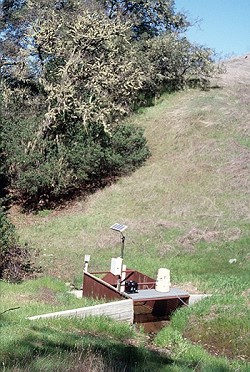Paired Watershed Research

The team's goal is to develop an understanding of the complex interactions of soil, geology, vegetation, and land use management with watershed function within these watersheds. The team includes Barbara Allen-Diaz, range ecology professor at UC Berkeley; Ken Tate, rangeland watershed specialist at UC Davis; Randy Dahlgren and Mike Singer, soil science professors at UC Davis; Rob Atwill, environmental health specialist with the School of Veterinary Medicine at UC Davis; and David Lewis. The network of coastal and sierrain watersheds, dominated by oak woodland, was established with the support of the University of California Integrated Hardwood Range Management Program, and respective staff at the University of California Sierra Foothill and Hopland Research and Extension Centers.
 Stream flow is monitored at flumes installed at the outlet of each watershed. Water samples are collected throughout the winter at 1-2 hour intervals during storms and 3-4 hour intervals between storms. In addition, vegetation composition, structure, and pattern are being documented at the watershed scale.
Stream flow is monitored at flumes installed at the outlet of each watershed. Water samples are collected throughout the winter at 1-2 hour intervals during storms and 3-4 hour intervals between storms. In addition, vegetation composition, structure, and pattern are being documented at the watershed scale.
Currently, baseline data is being collected in order to 'calibrate' the watersheds before implementing treatments. During this calibration phase, the UC team is documenting relationships between the watersheds by comparing water quality (e.g. nitrate concentration) and yield measurements from each. Once the calibration phase is complete, the team plans to change grazing intensities and implement controlled burning within a subset of the watersheds, while maintaining current management in the others. The interactions of a treatment will be measured by detecting a significant change in the previously established relationship between the treated and control watershed.
Relevant Publications

